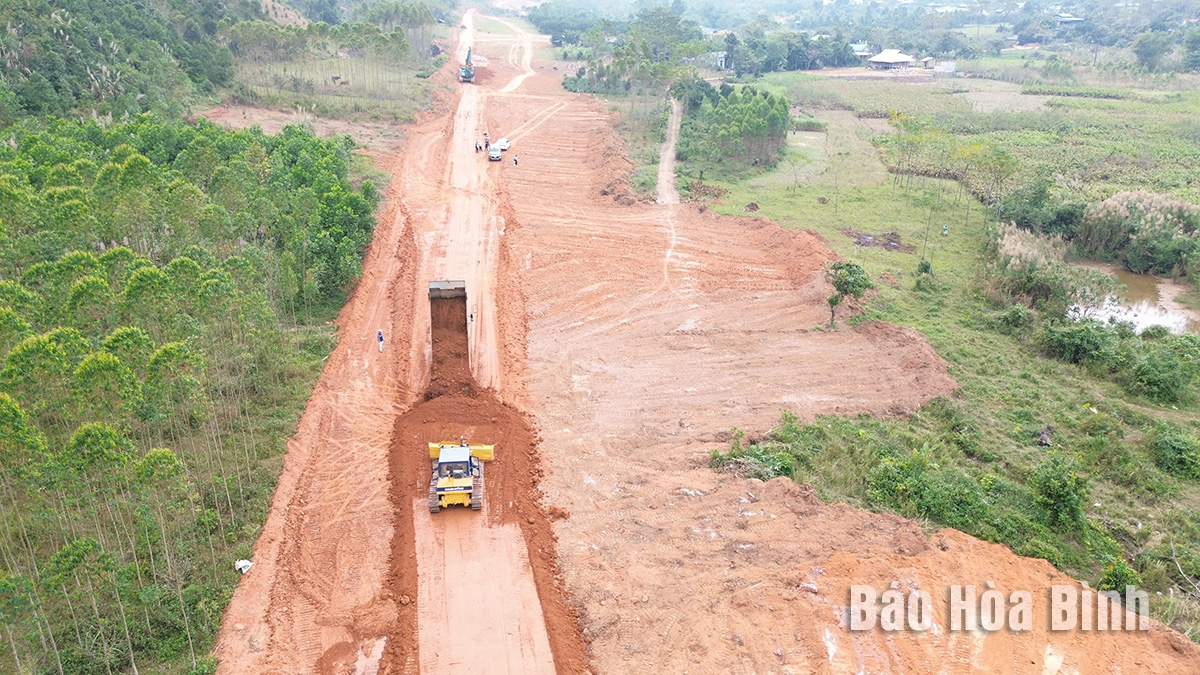
The air is thick with the hum of drills and the clatter of machinery as the Hoa Binh – Moc Chau expressway takes shape amid the rugged terrain. Welding sparks illuminate the faces of workers, and concrete mixers churn relentlessly, laying fresh pavement on the newly-carved road. The construction site buzzes with a palpable sense of urgency, particularly in Hoa Binh province where the expressway's future is being forged.

Machinery and materials are used to build Hoa
Binh – Moc Chau expressway.
Spanning nearly 34km through Hoa Binh, the expressway costs nearly 10 trillion
VND (400 million USD). After months of construction, the project has made
strides. As of early March, over 80% of the land clearance was completed,
allowing construction units to mobilise resources efficiently. Mai Chau
district has handed over all required land (10.15km), while Da Bac district has
cleared nearly 78% of its section (17 out of 21.75km). The Van Ho segment in
Son La province is in the final stages of compensation and clearance, with
completion anticipated by the second quarter.
This progress reflects the dedication and coordinated efforts of local
authorities, the provincial Party Committee, and the provincial People's
Committee.
Despite its progress, the project still faces challenges. The terrain is
unforgiving, with complex geological conditions and unpredictable weather,
including persistent fog and drizzle. Funding and disbursement issues also loom
large, posing concerns for stakeholders.
The final bidding and contracting for construction and consultancy packages are
slated for completion in March. Once finalised, the expressway will enter
full-scale construction, aiming to eliminate bottlenecks and maximise
efficiency before the rainy season begins.
With unwavering determination and coordinated efforts from all involved
parties, the project is steadily overcoming obstacles to accelerate progress.
The goal is to complete the expressway by 2027, a full year ahead of the
original 2028 schedule. This accelerated timeline underscores the urgency to
put the expressway into operation as swiftly as possible.
The People’s Committee of Hoa Binh province on May 16 held a conference to honour outstanding intellectuals for their contributions in 2025.
The Standing Board of the Hoa Binh provincial Party Committee has held a conference to announce the provincial Party Committee’s decision about the merger of Hoa Binh Newspaper and the provincial Radio and Television Station, along with the Standing Board’s appointment decisions.
After the historic victory on April 30, 1975, which liberated the South and reunified the country, the whole Vietnam embarked on a new mission — promoting peace and reconstructing the nation with century-defining projects. On the fierce Da River, over 30,000 engineers, sappers, and construction workers battled against rocky mountains and raging floods to achieve a remarkable feat. The Hoa Binh Hydropower Plant, the largest of its kind in Southeast Asia at that time, officially began generating electricity, lighting up the North and ushering in a new era of industrialisation.
Muong Dong in Kim Boi district, one of the four major Muong regions in Hoa Binh province, is harnessing its revolutionary legacy and cultural heritage to drive socio-economic transformation.
Throughout April, the joyful atmosphere of the 50th anniversary of the Liberation of the South and National Reunification spread nationwide. Together with the whole country, residents in Hoa Binh city also expressed their patriotism through meaningful and practical actions.
When requesting personal document verification and certification service at the one-stop-shop service section of Dong Tam Commune in Lac Thuy district, Nguyen Thanh Long, a resident of Dong Bong village, was both surprised and pleased with the professionalism and attitude of civil servants working there.



